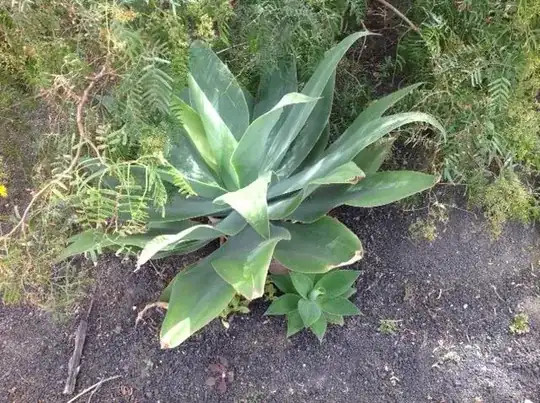I'm not sure exactly what plant it is, but I'd take an educated guess its one of the Agave or Aloe varieties. I can't tell if its got thorny tips, they seem a bit dehydrated and wilted, but there does appear to be some serration along the edge of the leaves.
You can separate the pup (offset), but in order to do this, you still need to loosen the soil around the mother plant. If you want to try moving the mother plant (you can separate the pup when you do), then take a garden fork, not a spade (though you'll need a spade later), and loosen the soil around the plant, starting a foot or 18 inches away. Insert the fork and gently move it upwards a little, do this all the way round, then go back in where you started and loosen more, continue this all the way round, working gently inwards. If you meet fibrous resistance, it will be quite hard to tell whether its the roots of this plant or the one behind, but eventually, you should be able to tell where one plant's roots are by excavating the loosened soil carefully (with the spade) so you can see what's there. I'd usually get down on my hands and knees and insert my hand close to the plant once you've got to this point, feeling around to try to find any deeper roots which may be coming from the plant, then dig a bit more if necessary to loosen those. If this plant is an agave, it will likely have a large taproot - you must not break this root, and it may go down quite a way.
If you manage to extract it from the ground more or less intact, then deal with the pup - wiggle it gently from side to side to loosen it slightly - you need to have some roots present on the pup itself, it needs those to keep growing once separated from the mother plant, so if you can't see any roots attached to it anywhere, it's better to replant the mother and pup and wait a bit longer to detach it. When you do detach it, either pot it up so you can give it the necessary tlc (tender loving care) until its big enough to plant out, or, if it has a good root system already, replant in the ground somewhere.
If you intend to replant elsewhere, its best to prepare the area you've chosen by digging it over well before starting the process described above - once you've got the plant out, dig a hole in the prepared area that's large enough to accommodate all roots without cramping or bending them, and without the base of the plant's topgrowth being lower or higher in the ground than it was before. Backfill with the soil you excavated, gently press it down all round with your foot, then water in well.
